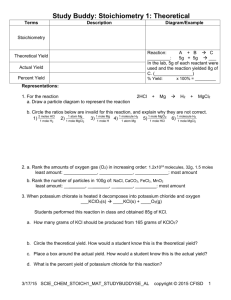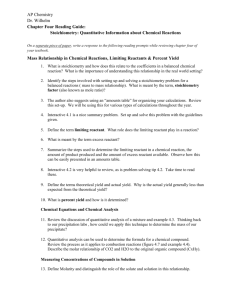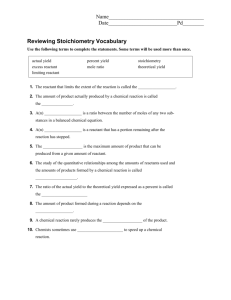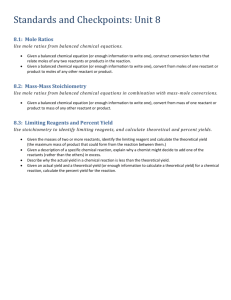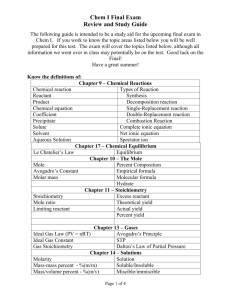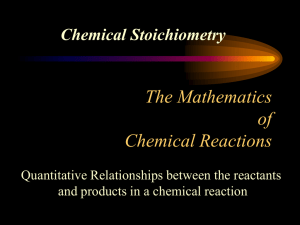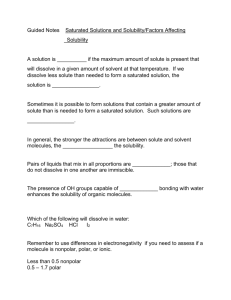2nd Sem Rvw
advertisement
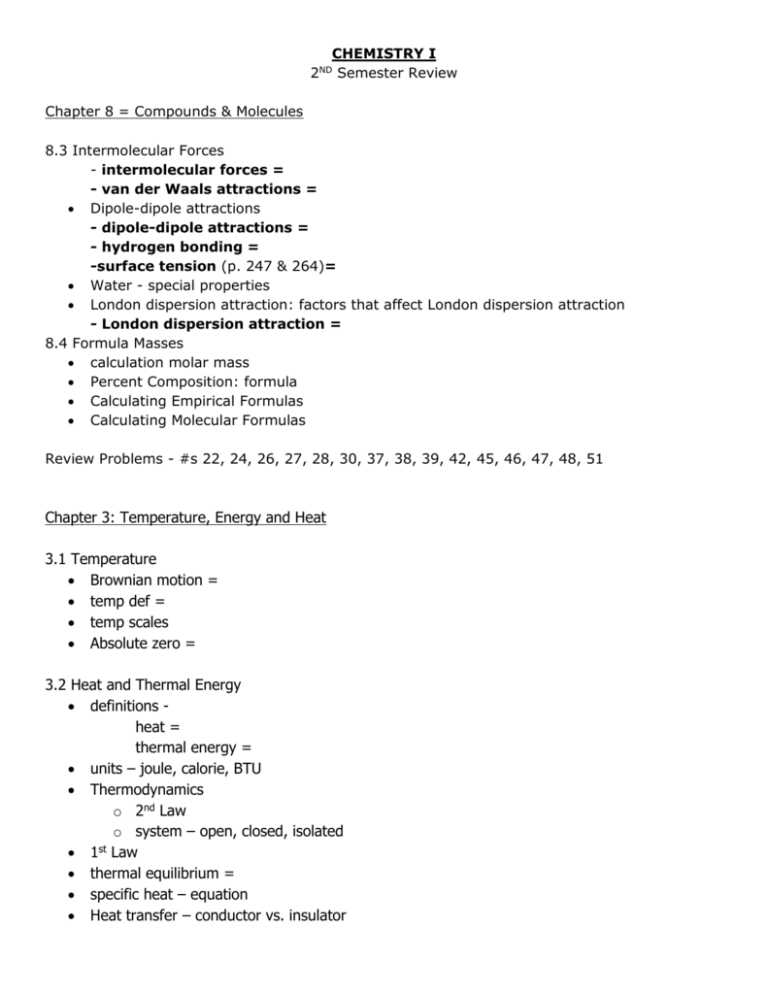
CHEMISTRY I 2 Semester Review ND Chapter 8 = Compounds & Molecules 8.3 Intermolecular Forces - intermolecular forces = - van der Waals attractions = Dipole-dipole attractions - dipole-dipole attractions = - hydrogen bonding = -surface tension (p. 247 & 264)= Water - special properties London dispersion attraction: factors that affect London dispersion attraction - London dispersion attraction = 8.4 Formula Masses calculation molar mass Percent Composition: formula Calculating Empirical Formulas Calculating Molecular Formulas Review Problems - #s 22, 24, 26, 27, 28, 30, 37, 38, 39, 42, 45, 46, 47, 48, 51 Chapter 3: Temperature, Energy and Heat 3.1 Temperature Brownian motion = temp def = temp scales Absolute zero = 3.2 Heat and Thermal Energy definitions heat = thermal energy = units – joule, calorie, BTU Thermodynamics o 2nd Law o system – open, closed, isolated 1st Law thermal equilibrium = specific heat – equation Heat transfer – conductor vs. insulator 3.3 Phase Changes def = melting point, boiling point heat of fusion, heat of vaporization solving probs evaporation and condensation Chapter 9 = Water & Solutions 9.1 Solutes, Solvents & Water - solution = - solvent = - solute = - dissolved = - polar = - hydrogen bond = Water: properties, importance of hydrogen bonding Universal solvent: why? - hydration = state of matter symbols: (s), (l), (g), (aq) - aqueous = Why are aqueous solutions important? Other solvents: nonpolar 9.2 Concentration & Solubility - concentration = - dilute = - concentrated = - solubility = Ways to measure concentration: grams per liter , percent mass, molarity Molarity: why is it useful? - molarity = Equilibrium - saturated = - aqueous equilibrium = Solubility & Temperature: effect of temperature on solubility Dissolving Rate: effect of changing particle size on dissolving rate, effect of temperature on dissolving rate Solubility of Gases: effect of temperature on gas solubility, effect of pressure on gas solubility 9.3 Properties of Solutions reaction rate: effect of concentration & temperature Energy & solutions: exothermic, endothermic - heat of solution = - enthalpy = - calorimetry = Solution calorimetry: heat lost must equal heat gained: net change is zero. Density, freezing & boiling: effect of solute on these properties of the solution vs. pure solvent Colligative Properties: freezing point depression formula - colligative property = - entropy = - molality = -electrolyte = Review Problems - #s 30, 32, 40, 41, 48, 54, 57, 60, 66, 71, 74 Chapter 10 = Chemical Reactions 10.1 Chemical Equations & 10.2 Methods for Balancing Chemical Equations Language of chemistry - chemical reaction = - chemical equation = - reactants = - products = Conservation of Mass - law of conservation of mass = - balanced chemical equation = - coefficients vs. subscripts 10.3 Types of Chemical Reactions Synthesis: general formula, definition Decomposition: general formula, definition Single displacement: general formula, definition Double displacement: general formula, definition, precipitate reactions Precipitates & Solubility: solubility rules Polymerization reactions 10.4 Chemical Reactions & Energy exothermic (ΔH<0) vs. endothermic (ΔH>0) Thermochemical equations - enthalpy of formation = exothermic & endothermic = reverse reactions Calculating enthalpy change: role of coefficients Energy profile: total bond energy vs. reaction progress Energy barrier - energy barrier = - spontaneous = Hess's Law - Hess's Law = enthalpy = state function = depends only on final & initial states Review Problems - #s 30, 32, 38, 39, 41, 43, 46 Chapter 11 = Stoichiometry 11.1 Analyzing a Chemical Reaction - stoichiometry = Interpreting the chemical equation - coefficients Determining mole-to-mole relationships - stoichiometric equivalent Using the Mole Ratio - mole ratio = Practicing with mole ratios: mole to mole conversions Gram to gram conversions 11.2 Percent Yield & Concentration: - percent yield = - actual yield = - theoretical yield = Percent yield: formula Calculating percent yield: calculate theoretical yield, measure actual yield Stoichiometry with solutions: use molarity or percent mass to calculate moles 11.3 Limiting Reactants - limiting reactant = - excess reactant = Determining the limiting reactant: never compare reactant masses in grams, always convert to moles of each reactant Using the limiting reactant: limiting reactant determines how much product can form 11.4 Solving Stoichiometric Problems Key ideas – p. 353 Review Problems - #s 11, 17, 24, 32, 33 Chapter 13 = Acids & Bases 13.1 The Chemical Nature of Acids & Bases - neutral = - acid = - base = The importance of the H+ ion - Arrhenius theory = - hydronium ion = Brønsted-Lowry definition - acid = - base = -amphoteric = Brønsted-Lowry: acid-base pairs Identifying acids/bases: acids have leading "H", strong bases have "OH" - strong = - weak = 13.2 The pH Scale: acids-pH<7, neutral-pH = 7, bases-pH>7 -logarithm = Definition of pH Calculating pH for acids Calculating pH for bases pH indicators - indicator = 13.4 Acid-Base Reactions: neutralization, corrosion & etching Neutralization - neutralization = Titration - titration = - equivalence point = Salts - salt = Salts of weak acids-raise pH; salts of strong bases do not affect pH Buffers - common ion = - buffer = - buffer capacity = Review Problems - #s 21, 23, 24, 27, 29, 30, 31, 32, 35, 40, 44, 52, 58,60 Chapter 14 = Gases 14.1 Pressure & Kinetic Theory -kinetic molecular theory = -Brownian motion = - pressure = - standard pressure = measuring pressure Kinetic theory of pressure: molecular impacts; effect of temperature, effect of density 14.2 The Gas Laws Boyle's Law – volume vs. pressure: P1V1 = P2V2 Charles's Law – volume vs. temperature: V1 = V2 T1 T2 Kelvin temperature scale The Combined Gas Law: P1V1 = P2V2 T1 T2 The Ideal Gas Law: PV = nRT Universal gas constant – choosing the correct value for "R" Molar volume = 22.4 L 14.3 Stoichiometry & Gases Gas – solid calculations Gas – solution calculations Gas – gas calculations Review Problems - #s 18, 19, 21, 23, 24, 28

